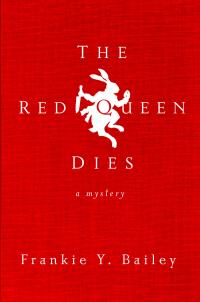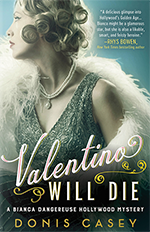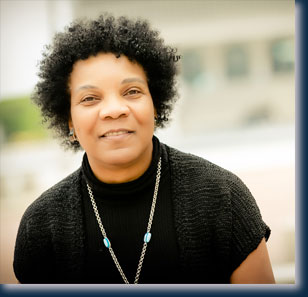Merry Christmas, Happy Hanukkah, and Happy New Year everyone, and what a Christmas treat I have for you. December’s guest is Frankie Y. Bailey, PhD, professor in the School of Criminal Justice University at Albany (SUNY). She studies crime history, and crime and mass media/popular culture and material culture. She is the author of five mysteries featuring amateur sleuth Lizzie Stuart and two police procedurals novels featuring Albany police detective Hannah McCabe. Frankie is currently at work on a non-fiction book about four hundred years of dress and appearance in American crime and justice. She is also working on a historical thriller set in 1939 and her next mystery novel. Frankie is the project director of the Justice and Multiculturalism in the 21st Century project in the School of Criminal Justice (UAlbany). Join me for Frankie’s fascinating story about dealing with history, mystery, and multiculturalism!
Frankie Bailey
Like a Butterfly Pinned to a Board
“Like a butterfly pinned to a board.”
That’s the first line I can remember writing. I know it must have been in an English class in high school, probably as an assignment to write a poem. When I was in high school, I was honor-roll smart and on the academic track. I was preparing for college even though my parents didn’t have the money to send me. I was also shy and awkward, but my mother and I had frequent yelling matches about silly things that I can barely remember now. It certainly couldn’t have been about boys or dating because the one time a boy asked me out, I was so shocked I stammered, “No” and literally ran in the other direction. Since he was the manager for the school basketball team, I also missed my opportunity to attend a game.
One of the reasons I didn’t have a social life was that I lived “out in the country,” a few miles beyond the city limits in what we would now call the suburbs of Danville, Virginia. We had no sidewalks and drove into town. I couldn’t get my driver’s license until I was sixteen and by then my status as one of those girls that read books and didn’t date had been established. On weekends, I read romance novels, historical novels – even better if they combined both – and mysteries, espionage, and thrillers. I also loved Gothics. Add to that how much television and how many old movies I gobbled up, and that explains not only what I write but what I do as a criminologist (crime history, mass media, popular culture).
I intended to do something else. But in my last year in high school, the school I had been attending was turned into a junior high, and seniors were bused to another high school. This was as Virginia finally lost the struggle and fully implemented Brown v. Board of Education. That senior year had a profound effect on the rest of my life because my new guidance counselor was white. When she asked what I wanted to do, I told her I loved animals and wanted to be a vet. She said I should apply to Virginia Tech. She probably didn’t know a lot about Historically Black Colleges and Universities (HBCUs). She probably also thought that having made it through the science program at Virginia Tech would look more impressive on my transcript. Except I didn’t.
I love animals. But at VA Tech, I realized I wanted to be like Dr. Jane Goodall not “Dr. Dolittle” (the nickname one of my older cousins had given me). I still didn’t like dissecting frogs, and I wasn’t getting off to a good start in university-level biology and chemistry courses. I had gotten my first “C” ever in the first chemistry course I was required to take. That was a downer because I was going to have to buckle down and spend the next four years trying to keep my grades up and hold onto my scholarship that was already being supplemented by my parents. I would need to be an honor student because Virginia had no vet school at the time, and only a few students were admitted to out of state schools. I chickened out (pun intended) and decided to rethink my career choice.
I spent the next year in academic limbo. I make regular visits to the Counseling Center to chat (like one of those neurotic patients on The Bob Newhart Show) with my favorite psychologist. I enjoyed having someone listen while I dissected my college experience. I was excited when he suggested I take an aptitude test. We discovered I shared traits with those in two professions – Writer and Military Officer. Writers, okay. But Military Officer? True, I had watched a lot of John Wayne movies and loved James Garner in Darby’s Rangers. But I knew the lyrics of “The Ballad of the Green Berets” only because I liked ballads and that one was memorable. I had grown up in Danville, the “Last Capital of the Confederacy.” I was attending Virginia Tech, where the college green is called “the Drillfield” and the cadets live on “the Upper Quad” and wear their uniforms to class. But I was not cut from military fabric. What I found fascinating about the military was the courage that soldiers display in situations that would send me running fast in the other direction. I was also intrigued by the concept of “honor” and how it was used in the South. Years later I spent a lot of time looking at how honor was an aspect not only of senseless duels and the Civil War but of relationships between slaveowners and their slaves.
I was interested both in Psychology and English. I decided to do a double major — Psychology (practical) and English (fun). Did I mention that when I was in high school, I sent off for information about The Famous Writers School correspondence course? A sale representative turned up at our door, and my parents (who believed anything to do with education was a good thing) listened and signed me up. I didn’t finish the program because I lost interest in the exercises. I don’t know what distracted me because I still have the folder with comments from the instructors. I came back to writing after I discovered a writer who intrigued me.
One of the last courses I took at Virginia Tech was in the Theater Department. Not because I had any interest in being an actor, but because I had done three quarters of Shakespeare with a wonderful professor who traveled to England every year. Shakespeare was already in my psyche by the time I got to Tech. In high school we had read “Romeo and Juliet” and “MacBeth” and “Hamlet” and then seen the film adaptations. I still turn to my old Complete Volume when I need to kick start my brain. My first short story featuring Jo Radcliffe, a former WW II Army nurse, involves a community theater production. Jo is at loose ends after returning home and inheriting her aunt’s house in a village in upstate NY. She volunteers to be the stage manager. I sold that story to Ellery Queen Mystery Magazine (Nov/Dec 2017). The title is “The Singapore Sling Affair” because I found some information about Somerset Maugham when I was trying to come up with a play that would bring my suspects together for a theater murder.

In The Red Queen Dies (the first of two books in my Hannah McCabe series that I hope that to revive), a Broadway actress (famous for her roles in Alice in Wonderland) comes upstate to Albany. She is here to work on her play while doing workshops in the Theater Department at UAlbany. The play the actress is working on is about the true story of the actress who was involved with John Wilkes Booth. He was here in Albany when Abraham Lincoln and his wife arrived by train for an overnight stay. In fact, he was probably there among the onlookers when the Lincolns passed by en route to their hotel. A traveling player, Booth returned to Albany a few months later. He was having an affair with an actress in the troupe, and during a drunken argument, she tried to stab him. Of course, if she had been successful in doing him in, Booth wouldn’t have been in Washington, D.C. when Lincoln and his wife decided to go to the theater. The major and his fiancée who were standing in for the Grants as guests of the Lincolns were from Albany. A former hatmaker from Troy (near Albany) was in the military unit that pursued Booth, and he is said to have killed him. My fictional actress was fascinated by Albany’s role in the Lincoln-Booth saga and about how little was remembered about the real-life actress (who had gone on with her 19th century career),
I was fascinated, too, and I let nothing that strikes a chord go to waste. When an editor who was with St. Martin’s at the time asked what I was working on, I came up with a near-future police procedural series because I had done ridealongs with female police officers while I was a member of a team during research on how stress affected police officers in a large department. The research was done in another city, but I had learned enough to apply it to Hannah McCabe, my fictional Albany police detective, and her new male partner. The Alice in Wonderland theme of the book popped into my head when I was looking for a hook and happened to glance up and see my copy of the book on a shelf in the room divider that I had asked my contractor to build after seeing it on the HGTV website. It rises from floor to ceiling with more space overhead. McCabe stepped into the space in my head as the daughter of a retired newspaper editor and UAlbany alum.
Lizzie Stuart, my Southern protagonist was born and raised in the small town of “Drucilla, Kentucky” (fictional, but I did teach in Frankfort, KY for six years). She was working on her dissertation here in Albany when she took a break to spend a weekend in Boston with Tess Alvarez, her roommate from college. She was there when Tess met the man she would later marry and then divorce. Lizzie mentioned that when she was filling in the backstory of their relationships in Death’s Favorite Child, the first of five books in her series. I was in Cornwall when I was writing that book because my best friend from grad school had invited me to meet her there for a week’s vacation. In the book, my friend morphed from crime justice professor to travel writer and from European American to Puerto Rican. Her six year old son who was with her became the inspiration for the little boy in my book. I had already decided to write a book that would be my take on an Agatha Christie detective novel with a closed circle of suspects and an amateur sleuth. But I wanted to use the sleuth who was in the book I had been working on for ages. She was African American and a criminal justice professor who knew enough about crime investigations to be able to hold her own with the two police officers on the case. The novel was set in a private hotel like the one where my friend Joy and I were staying. The proprietors had graciously agreed. The British police inspector who I told I was going to have a murder in his village on the seashore only raised an eyebrow and told me politely that they rarely had a homicide there. But inspired by Agatha – I made a presentation at the Agatha Christie Festival this September – I committed murder by “yummy ball” (a peanut allergy). Lizzie saw it happen.
Lizzie is now a professor in “Gallagher, Virginia” – the stand-in for my hometown, Danville. I added a major university to the geography of the city to give Lizzie a reason for being there and I’ve fictionalized a couple of real-life cases from Virginia history. Wherever she goes I go first and use the research to insert the story into whatever I find. John Quinn was supposed to have been the Gallagher police chief that Lizzie encountered when she came to find out about her secretive grandmother’s past. But in the Cornwall book, he decided to be a Philadelphia homicide detective. That’s because in Cornwall, Joy had spotted a police officer and told me to run over and ask him if I wanted to know where to find the police station. I did, and he grinned and told me in an accent straight out of Chicago. He had retired to England with his Scottish wife. He was in uniform because he was a special constable during the summer months. Right away, I realized that Lizzie would have a connection to the police department if John Quinn, a homicide detective, was there on vacation, visiting his former partner. And it would work even better if Lizzie had already met John Quinn and they both had seen the young woman who worked in her aunt’s private hotel and who was going to be the victim having an argument with her boyfriend. Better if Quinn was staying with his friends. But if he was a runner and out that morning when Lizzie ran down from the cliff walk looking for help . . .
By now, you understand how my mind works. I free associate. My friend, Alice Green — who came up with a recipe for the yummy ball in my first book and is the inspiration (although much younger) for the owner of the “Orleans Café” in my series — warns people that what they tell me may make it into a story in some form. The tree that she told me had blown down in a gust of wind at her summer house in the Adirondacks became the tree that was struck by lightning in Drucilla, Kentucky in the first chapter of Death’s Favorite Child.
The Lizzie series debuted in 2000 and is still only in 2004. Only two years have passed in series time. When I realized this, I thought of how writers play with time in soap operas like The Young and the Restless. I made Wade Garner’s wife a former soap opera star. Wade and John Quinn were at West Point together because I have this thing about honor and West Point is here in New York. In case I forgot to mention, I did eventually end up in the Army – as a food inspector in Seattle (a city I had wanted to visit because I was a fan of a television show called “Here Comes the Brides”). I happened to be passing by the Army Recruiting Office and stopped to look at a poster. The recruiter lured me in. I spent three years in the Army that turned out to be useful when I was imaging John Quinn.
The Lizzie Stuart books are being reissued by Speaking Volumes, with pauses as I work from manuscripts that were in outdated software. Old Murders, the third book in the series is already in ebook and coming out soon in print. I have the plot for the sixth book in the series. The first few chapters are set in Santa Fe because I wanted an excuse to go there. I’ve wanted to since I read Richard Martin Stern’s Johnny Ortiz series as a teenager. Mr. Stern answered my letter with one of his own when I wrote to tell him how thrilled I was to discover Dr. Cassandra “Cassie” Enright, a biracial woman in his books. She was the first woman of color I had encountered in a mystery and she was an archeologist. I decided to make Quinn white because I wanted to build in the conflict he would have with Lizzie, my black criminal justice professor. I also wanted to have a multicultural cast. That was something I admired about both Mr. Stern’s books and those by Eleanor Taylor Bland, the author of a series of novels featuring an African American female homicide detective.
Right now, I’m working on a historical novel in 1939 because of four events that year as America was about to enter the war. But this essay is getting much too long. I will cover that in my Author Note when I finally finish the book and if my agent can sell it. It’s the most complex book I’ve ever plotted and I hope I can pull it off.
Many thanks to Donis for this invitation to ramble on. Happy Holidays, everyone.
_________
Check out Frankie’s website at https://www.frankieybailey.com




December 27th, 2022
Thanks for sharing your evolution as a mystery writer, Frankie, and your reflections on the inspiration for your stories and characters. I’m eager to read your work. Thank you, Donis for shining the spotlight on this author.